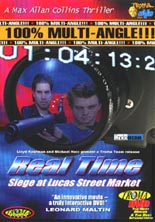
 Francis Lawrence (Constantine) didn’t have to work too hard to clear the bar Gary Ross set in 2012 with the dull adaptation of The Hunger Games. I wish he had anyway, because Catching Fire does just that only about halfway in, and then never roaring.
Francis Lawrence (Constantine) didn’t have to work too hard to clear the bar Gary Ross set in 2012 with the dull adaptation of The Hunger Games. I wish he had anyway, because Catching Fire does just that only about halfway in, and then never roaring.
Assuming audiences have digested the previous film and its Battle Royale of a plot, Catching Fire catches Katniss Everdeen (Jennifer Lawrence, American Hustle) and Peeta Mellark (Josh Hutcherson, 2012’s Red Dawn remake) ditching their potato-sack wardrobe to embark on a victory tour of the nation’s 12 districts and sell the illusion of a romance to the huddled masses. Instead, they deviate from the government script and Katniss becomes a “beacon of hope for the rebellion. She needs to be eliminated,” orders nefarious President Snow (Donald Sutherland, Space Cowboys).
 To do that, Snow forces the pair into another round of Hunger Games, this time an all-stars edition planned by Plutarch Heavensbee (Philip Seymour Hoffman, The Master). As Head Gamemaker for the Capitol, he creates a deadly beach scenario full of such frights as angry monkeys, blister smoke and Amanda Plummer.
To do that, Snow forces the pair into another round of Hunger Games, this time an all-stars edition planned by Plutarch Heavensbee (Philip Seymour Hoffman, The Master). As Head Gamemaker for the Capitol, he creates a deadly beach scenario full of such frights as angry monkeys, blister smoke and Amanda Plummer.
Once Lawrence — the director, that is — gets his young stars into combat, the movie becomes mild fun to watch. Before that, it’s almost as bland and plodding as Ross’ work, which mistook its dystopian setting as a mandate that it also couldn’t have a soul. Dozens of characters with names that sound like failed foreign breakfast cereals return, but Mr. Lawrence is able to inject the proceedings with more juice. Too bad his leads remain ever languid.
The one thing that the original The Hunger Games had that Catching Fire does not is an actual ending. What viewers get here is not just a cheat, but a bout of expository diarrhea. It is possible to give a story closure while leaving some threads dangling for the next chapter; this one is all damned dangle. —Rod Lott


 “How are you going to kill me this time?” she asks teasingly, as she takes her lover into her arms.
“How are you going to kill me this time?” she asks teasingly, as she takes her lover into her arms. 

 To grant
To grant 



